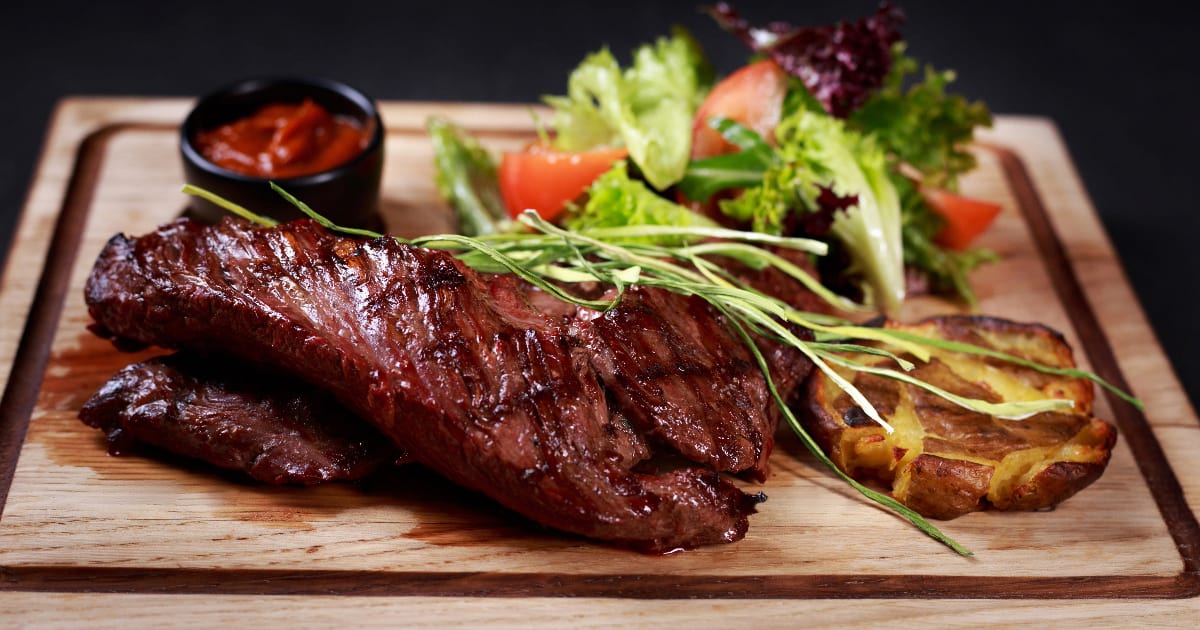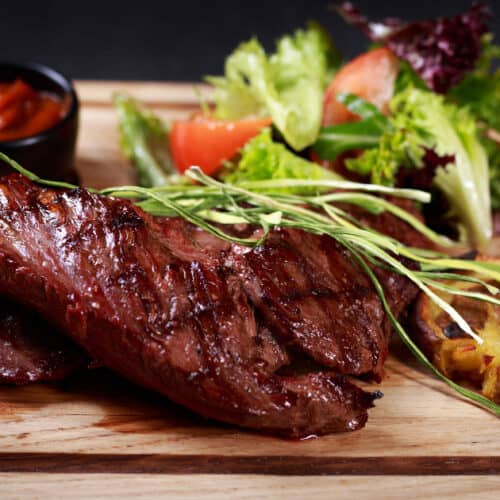Gochujang, a savory and slightly spicy Korean fermented chili paste, makes an ideal marinade for steak. It infuses the meat with sweet, spicy, and umami flavors that caramelize into an incredible crust when seared over high heat.

When blended with staple marinade ingredients like soy sauce, garlic, ginger, and sesame oil, gochujang creates a Korean-inspired flavor profile that works exceptionally well with beef. The cut of steak used can vary based on taste and budget, but skirt steak is most commonly used for its tenderness and its ability to absorb flavors from a marinade.
Gochujang: The Star of This Marinade
Gochujang is a thick, sticky Korean condiment made from chili peppers, glutinous rice, fermented soybeans, salt, and sometimes sweeteners like honey or sugar. Its savory, slightly sweet taste comes from the fermentation process.
The fermented soybean element gives gochujang an incredible umami flavor, while the chili peppers bring heat and fruitiness. The complexity of flavors is what makes it ideal for marinating beef. It tenderizes while packing a flavor punch.
When shopping for gochujang, you can find it in mild, medium, and hot spice levels. The medium spice level works well for balance in a steak marinade. Some contain added sugar, which helps the gochujang caramelize nicely on the steak as it cooks.
Look for gochujang sold in a tub or squeeze tube. Avoid cans or jars, as exposure to air can cause gochujang to spoil quickly after opening. Store it in the refrigerator once opened.
Building Flavor With Aromatics
While gochujang supplies the bulk of the big, bold flavor in this marinade, combining it with aromatics amplifies and balances the taste.
Onion adds sweetness to balance the heat. Grate it before adding to the marinade so it can quickly infuse flavor.
Garlic and ginger provide pungency and bite. For maximum flavor extraction, grate the garlic and ginger instead of chopping.
Scallions give freshness and subtle oniony flavor without overwhelming sweetness. Use both the white and green parts.
Sesame oil provides nuttiness that complements the sesame seeds often used as garnish on gochujang steak. A little goes a long way, so use it sparingly.
Building Savory Depth with Soy Sauce and Rice Wine Vinegar
Soy sauce and rice wine vinegar round out the classic flavor trio in Korean marinades.
Soy sauce packs a savory umami punch that enhances the meatiness of the steak. Go for a low-sodium variety to allow the other flavors to shine.
Rice wine vinegar brightens the marinade with acidity to cut through the rich flavors. It also tenderizes the meat. Substitute apple cider vinegar in a pinch.
This classic combination perfectly balances and blends with the gochujang, allowing its flavor to take center stage while still getting brightness and savoriness.
Best Cuts of Steak for Gochujang Marinades
While gochujang can lend flavor to any cut of beef, certain steak cuts are ideal for marinating and stand up especially well to the strong Korean flavors.
Skirt steak is the most popular choice. It is thin with a fat cap along one side, so it tenderizes quickly and absorbs tons of flavor from the marinade. When sliced against the grain, it has a terrific texture.
Flank steak is another excellent option. It has a similar thinness to skirt steak. Be sure to slice against the prominent grain after cooking.
Hanger steak is incredibly beefy in flavor, with a loose grain that makes it tender. Its richness loves the flavor of gochujang.
The sirloin flap comes from the bottom sirloin, giving it great beefiness. Sliced thin, it does well with marinades.
Tri-tip is another good sirloin option. It is small in size but packs a big beefy flavor. Let it soak up the gochujang overnight before cooking hot and fast.
Marinating Times for Maximum Flavor
Marinating is key for letting the gochujang infuse its flavor into the meat. But exactly how long should the steak soak?
For the fullest flavor penetration, marinate the steak for 1-2 days in the refrigerator. The long marinating time allows the beef to become ultra-tender and take on the taste of the gochujang.
If you're short on time, you can get away with a minimum marinating time of 1 hour. The flavor will still come through nicely.
For marinating times in between, aim for 4-8 hours for a very good flavor infusion.
No matter the marinating time, be sure your steak is in a sealed bag or container, fully submerged in the gochujang mixture. Turn the bag over occasionally to distribute the marinade.
Cook High and Hot for Caramelization and Tenderness
Cooking over high, dry heat is vital for getting the best texture and flavor out of gochujang marinated steak.
The sugars and starch in the gochujang will caramelize over the intense heat, forming a beautiful crust on the meat that adds a wonderful depth of flavor.
Cooking quickly over high heat also gives you a better chance at a tender, juicy interior. Long cooking times can toughen the muscle fibers.
To cook the steak:
- Remove the steak from the fridge 30 minutes before cooking to take the chill off.
- Pat the steaks dry before seasoning lightly with salt.
- Get a cast iron skillet very hot over high heat. Use an oil with a high smoke point like avocado or grapeseed oil.
- Add the steak and sear undisturbed for 2-3 minutes per side. Use tongs to flip instead of a fork to avoid losing juices.
- Don't worry if the steak blackens in spots - this adds to the flavor!
- Remove the steak from the skillet and let rest for 5-10 minutes before slicing against the grain.
Serving Suggestions for Gochujang Steak
This flavorful gochujang marinated skirt steak sings on its own, but can also be served with an array of classic Korean flavors and ingredients:
- Steamed rice: The ideal accompaniment to soak up the juices. Try purple or black rice for a beautiful visual contrast.
- Lettuce wraps: Wrap bites of steak and extra gochujang sauce in lettuce leaves for handheld fun.
- Kimchi: The fermented cabbage provides probiotics and cuts through the rich meat.
- Scallions and sesame: Garnish the rested steak with chopped scallions and sesame seeds for texture and a burst of flavor.
- Gochujang aioli: Mix gochujang into mayonnaise for a spicy dipping sauce.
- Asian pear salad: Thinly sliced pears in a vinaigrette balance the heartiness of the steak.
However you choose to serve it, gochujang marinated skirt steak is sure to be a hit at your next barbecue or dinner party. The complex layers of flavor are hard to beat!
Frequently Asked Questions
What cut of steak can I use instead of skirt steak?
Flank steak and hanger steak are the closest alternatives. Fattier cuts like ribeye and strip steak will also work but may not absorb as much marinade flavor.
Can I marinate the steak for less time?
Yes, you can marinate for as little as 1 hour, just know that the flavor will not be as intense. 4 hours is a good minimum.
What if my steak overcooks and gets tough?
Unfortunately, overcooked steak will be tougher. Try slicing it extra thin against the grain. And learn for next time - pull it off the heat earlier and allow carryover cooking to finish it to the desired doneness.
Can I use pre-made gochujang instead of the paste?
Yes, you can substitute gochujang powder or other jarred gochujang products. The flavor may be a bit less vibrant than fresh gochujang paste.
What sides go well with gochujang steak?
Steamed white or purple rice, kimchi, Asian pear salad, and lettuce wraps are some of the most popular pairings.
Conclusion
With its sweet, savory, and spicy flavors, gochujang is an ideal marinade base for beef steak. Allowing skirt steak or other thin cuts to soak overnight infuses tons of Korean flavor into the meat. Searing over high heat caramelizes the exterior to perfection.
Slice your gochujang marinated skirt steak thin against the grain for the most tender, tasty bites topped with extras like sesame seeds and kimchi. This fusion of American steakhouse flavors and Korean barbecue is sure to please any crowd.

Gochujang Marinated Skirt Steak
Ingredients
- 1 lb skirt steak
- 1/4 cup gochujang (Korean chili paste)
- 3 Tbsp rice wine vinegar
- 2 Tbsp soy sauce
- 1 Tbsp grated ginger
- 3 garlic cloves, minced
- 1 bunch scallions, chopped
- 1 Tbsp vegetable oil
- Salt and pepper
Instructions
- Make the marinade: In a small bowl, combine the gochujang, rice wine vinegar, soy sauce, ginger, garlic, and scallions. Whisk well to fully blend.
- Add steak: Place the skirt steak in a resealable plastic bag. Pour in the gochujang marinade. Seal the bag, removing excess air. Turn the bag to coat the steak fully. Refrigerate for 1-2 days, flipping occasionally.
- Cook the steak: Heat a grill or cast iron skillet over high heat. Remove steak from marinade and pat dry. Brush with vegetable oil and season with salt and pepper.
- Grill or sear for 3-5 minutes per side for medium-rare doneness. Transfer to a plate and let rest 5 minutes.
- Slice and serve: Thinly slice steak against the grain. Serve with desired sides like rice, kimchi, sesame seeds, etc. Enjoy!

